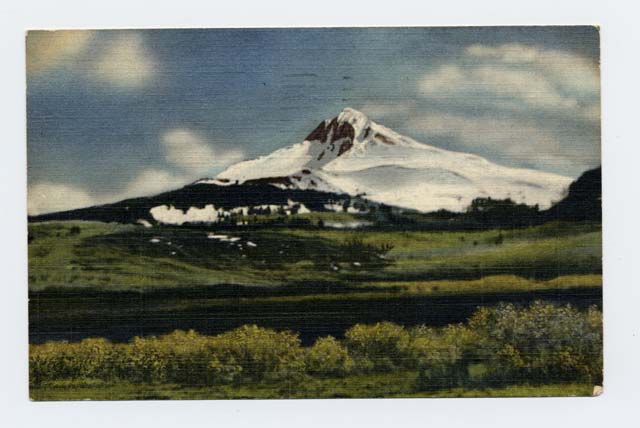Tips for determining when a
|
Source: Much of the contents of these guidelines were excerpted with permission from the Beginner’s Guide to the Hobby of Postcard Collecting, The Capital of Texas Postcard Club. Thanks also to Chuck Harbert; and to Nina Webber, whose donated postcards are used for the examples on this page. Compiled by Todd Ellison, Certified Archivist (last revised 8/7/2006)
By the style of the era:
(Sources:
A
Short History of the Post Card in the United States,
compiled by Mr. John H. McClintock. Also,
"Picture
postcards and the picture researchers: a personal case study," by Lewis
Foreman, in The Audiovisual Librarian, Vol. 12, Nov. 1986, p. 198-199.
Also,
The Picture Postcard and Its Origins, by Frank Staff (N.Y.: Praeger, 1966).
Pioneer Era (1893-1898)
Although the world's first picture postcards date from the
1860s to the mid-1870s, most of the earliest American picture postcards extant today are those that were
sold at the World Columbian Exposition in Chicago, Illinois, starting on May 1, 1893. These were illustrations on government-printed postal cards and
on privately
printed souvenir cards. The government postal cards included a printed 1-cent stamp;
the privately printed souvenir cards required a 2-cent adhesive postage stamp to be
attached. Messages were not permitted on
the address side of the cards; after attempting various forms of explaining that
regulation, the U.S. Post Office adopted the printed message that “This side
is for the address only” (Staff, p. 62). Other
backs from this pioneer era of the American post card are known today as “Souvenir Card” and “Mail Card.”
This period ended by July 1, 1898.
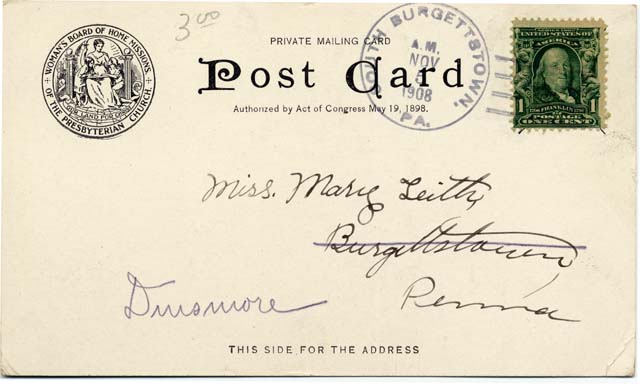
Private
Mailing Card Era (1898-1901)
An Act of U.S. Congress on May 19, 1898 granted private printers
permission to print and sell cards that bore the inscription
“Private Mailing Card.” Today these cards are referred to as “PMCs”.
The required postage was a 1-cent adhesive stamp. At this time, a dozen or more American printers began to take postcards seriously. Still,
no message was permitted on the address side. The term “Post Card” was not widely used until the early
1900s (it was later contracted to "postcard" as a word-counting
cost-saving measure).
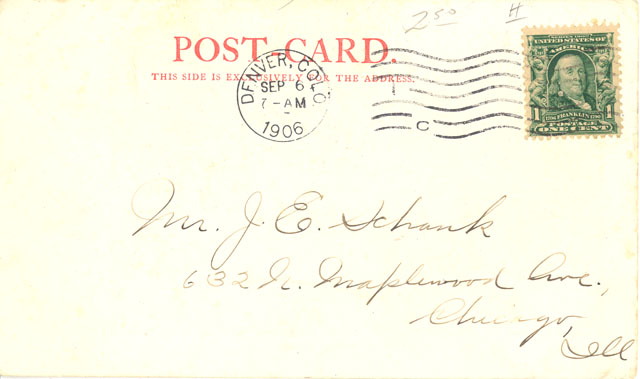 Post
Card Era - Undivided Back (1901-1907)
Post
Card Era - Undivided Back (1901-1907)
New U.S. postal regulations on December 24, 1901 stipulated
that the words “Post Card” should be printed at the top of the address side
of privately printed cards. Government-issued cards were to be designated
as “Postal Cards” (Staff, p. 62). Writing
was still not permitted on the address side. In this era, private citizens began to take black
and white photographs
and have them printed on paper with post card backs.
If no message was
permitted on the address side, the card probably pre-dated March of 1907.
Real Photo Postcards (1900-ongoing)
Postcards that are actual photographic
replications were first produced around 1900. They may or may not have a
white border, or a divided back, or other features of postcards, depending on
the paper the photographer used. Many of the real photo postcards being
done at the current time are reproductions of earlier historic photos. The
easiest way to distinguish a real photo postcard is to look at it under a
magnifying glass; it will show smooth transitions from one tone to another.
Click here for links for dating real
photos.
Early
Divided
Back Era (1907-1914)
Postcards with a divided back were permitted in the U.S. beginning on March 1, 1907.
(Britain had already pioneered this in 1902.) The address was to be written on the right side; the left side was for
writing messages. Many millions of
cards were published in this era -- it was the golden age of postcards. Up
to this point, most postcards were printed in Germany, which was far ahead of
the United States in the use of lithographic processes. With
the advent of World War I, the supply of postcards for American consumption
switched from Germany to England and
the United States itself.
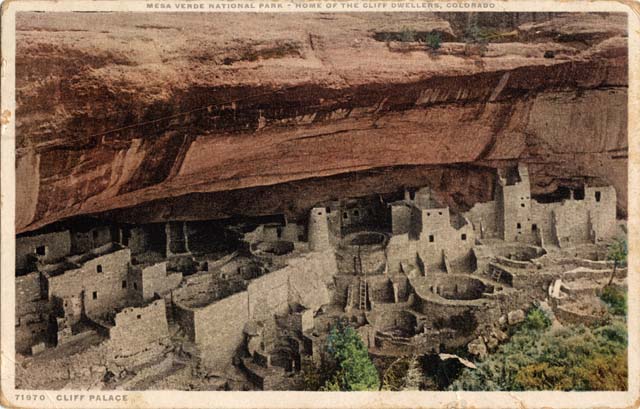
White
Border Era (1915-1930)
Most United States postcards were printed during this
period. To save ink, publishers left a clear border around the view, thus these postcards are referred to as “White Border” cards.
The relatively high cost of labor, along with inexperience and changes in public taste,
resulted in the production of
poor quality cards during this period. Furthermore, strong
competition in a narrowing market caused many publishers to go out of business.
Linen Era (1930-1945)
New printing processes allowed printing on post cards with
high rag content that caused a linen-like finish. These cheap cards allowed the use of gaudy dyes for coloring.
The firm of Curt Teich flourished because of its line of linen postcards. Many important events
and scenes in history are documented only by these cards.
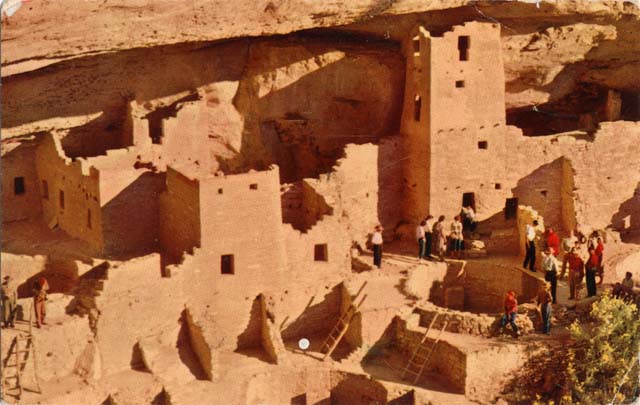
Photochrome Era (1939-ongoing)
“Chrome” postcards began to dominate the scene soon after the Union Oil
Company placed them in its western service stations in 1939. Mike Roberts pioneered his “WESCO” cards soon after World War
II. Three-dimensional postcards
also appeared in this era. By 1960s, the standard size
of cards had grown to 4 x 6 inches.
Photochromes are not real photos but rather, printed cards done by a photochrome process. To distinguish a printed postcard from a real photo postcard, examine it under a magnifying glass and you will see the dot pattern that is characteristic of printed cards.

"The best printed cards were produced done by the photogravure process. They are
difficult to discern from real photos but usually don't have the glossy finish
of photographs. The Laura Gilpin cards of Mesa Verde and Silverton are excellent
examples of the photogravure process." (Source: Chuck Harbert,
email to the author, 8/7/06)
By the postage:
One easy way to approximate when a
postcard was mailed if the cancellation date is unreadable is to know the
changes in rates for mailing postcards. The following table comes from Historical statistics of the United States: colonial times to 1970,
and Statistical abstract.
1872
1 cent
1917
2 cents
1919
1 cent *
1952
2 cents
1958 (August 1)
3 cents
1963 (January 7)
4 cents
1968 (January 7)
5 cents
1971 (May 16)
6 cents
1974 (March 2)
8 cents
1975 (September 14)
7 cents **
1975 (December 31
9 cents
1978 (May 29)
10 cents
1981 (March 22)
12 cents
1985 (February 17)
14 cents
1988 (April 3)
15 cents
1991 (February 3)
19 cents
1995 (January 1)
20 cents
*The postcard rate was increased from 1 cent to 2 cents as a wartime measure. When World War I ended at the end of 1918, the rate was lowered to its pre-War level of one cent. Allmer states (p. 17) that postage was raised briefly from 1 cent to 2 cents in 1917-1919 and in 1925-1928; the conclusive raise to 2 cents was in 1951.
**The U.S. Commission (Rate Board) over-estimated revenue needs in 1974 and was forced to reduce postage rate in 1975.
By the publisher's numbering scheme:
(Source: excerpted in
Beginner’s
Guide to the Hobby of
Postcard Collecting, The Capital of Texas Postcard Club,
from
Gloria’s Corner
PC Newsletter; Gloria’s Corner, PO Box 507, Denison, TX 75021-0507,
Phone/FAX (903)463-4878, Email gmj@texoma.net )
Two major postcard publishers, Curt Teich and Detroit Publishing Company, used numbering schemes that can be helpful in dating a card. ...
Curt Teich, Lake County Museum, 27277 Forest Preserve Dr., Wauconda, IL 60084.
In the beginning, Teich apparently made no attempt to define when a card was printed. Research has revealed some consistencies however, such as these:
Card number Year printed
28,000
1910
55,000
1915
80,000
1920
103,000
1925
124,181
December, 1928
In 1929, Curt Teich abandoned the consecutive numbering
system for an alpha/numeric production code.
The company used code numbers and letters to indicate the date the card
was published. The codes appear
either on the scenic side or in the postage box.
The number and letter before the dash in the code stand for the date.
The number indicates the last figure in the date and the letter indicates
the decade. The letters and figures
after the dash pertain to the printing process used and the number of issues
that year.
Code
Years
1-29 1929
A
1930-1939
B
1940-1949
C
1950-1959
D
1960-1969
E
1970-1974
Code number 3A-H107 is therefore translated to be printed in the year 1933. The “A” refers to the decade, the "3" refers to the third year of that decade, the "107" refers to that card being the 107th card printed that year. The "H" refers to the printing method called Art Colortone.
For more information, visit the Curt Teich Postcard Archives web site. The Archives is part of the part of the Lake County Discovery Museum, in Wauconda, Illinois.
The Detroit Publishing Company began numbering its cards with Number 1. #s 1 through 1000 were published between 1899 and 1901. Some of these same cards were later reproduced in the 5000 series. Detroit postcards are easy to manage by the number, regardless of subject.
Other clues: picture content, card size, printing process, phone/zip codes, and real photo postcard stamp boxes
Inherent content of the picture
may be helpful in dating (assuming that the postcard used a recent view).
The Official Identification and Price Guide to Postcards by Diane
Allmer (New York: House of Collectibles, 1990, ISBN 0-876-37802-5, page 16),
suggests looking at the following:
1. What style of clothes are the people wearing? [A useful book in this regard is Joan Severa’s Dressed for the photographer : ordinary Americans and fashion, 1840-1900 (Kent, Ohio: Kent State University Press, 1995), GT610 .S42 1995 in the Delaney Southwest Research Library Reference bookcase at the Center of Southwest Studies].
2. Look at the modes of transportation. Horse-drawn vehicles? What model of vehicles?
3. What clues can be drawn from the style of interior decorations, appliances, and furnishings?
4. Have the buildings been modified since the time of this view? (Dated photos in the Center’s General Photograph Collection may be useful for comparing with the postcard view.)
5.
Look for other time-related details.
For example, how many stars are in the U.S. flag?
Do the buildings have window air conditioners?
Is a wall calendar in the picture? If
we know a day of the week, the perpetual calendar at http://swcenter.fortlewis.edu/tools/PERPLCAL.HTM
may be useful for figuring out the year. A
history timeline such as at http://mediahistory.umn.edu/time/timeline.html
may be useful, too.
As Allmer notes (p. 17-18), postcard size can also be a clue.
Ø If the card is old and is larger than 3.5 by 5.5 inches, it may date from before 1898.
Ø If the card is old and is slightly smaller than 3.5 by 5.5 inches, it may date from 1898-1902.
Ø If the card measures 3.5 by 5.5 inches, it was probably made between 1902 and 1970.
Ø
If the card measures approximately 4 by 6 inches
(“continental” size) and is American, it was probably made no earlier than
the 1960s.
Allmer also suggests (p. 18) looking at the printing process:
Ø If the card was produced using high-quality chromolithography with six or more inks, it was probably made before 1917.
Ø If the card has a flat-textured surface and is printed with a limited range of low-contrast inks, it was probably made before 1930.
Ø If it has a linen-textured surface and is printed with sharply contrasting bright inks, it is likely from the period 1930-1960.
Ø If the card has a shiny surface and is printed in color using a halftone process (little dots of magenta, cyan, yellow and black), it was probably made no earlier than 1939.
Allmer notes (page 19) that "postcards created
directly from photographic negatives and printed onto photographic paper are
difficult to date when they have not been postally used." She refers
the user to Prairie Fires and Paper Moons by Hal Morgan and Andreas Brown
(Boston: David R. Godine, 1981) and "Dating Post-1920 Real Photo
Postcards," by Ernest G. Covington, in Postcard Collector, July
1986, pages 26-28.
Phone/postal numbers (Allmer, page 19):
Does it include postal mailing codes? The U.S. introduced the use of two-digit zone numbers on May 1, 1943; use of five-digit Zip codes began in July of 1963.
Does it list a phone number with area code? The first unassisted coast-to-coast direct dialing with a three-digit area code began on November 10, 1951.
Other clues on the back of a
postcard:
Real photo postcard stamp boxes: http://www.playle.com/realphoto/photoall.htm
Real photo postcard stamp backs: http://www.playle.com/realphoto/back.htm
![]() Guides
to the collections at the Center of Southwest Studies
Guides
to the collections at the Center of Southwest Studies
![]() Information for doing research at the Center
of Southwest Studies
Information for doing research at the Center
of Southwest Studies
Page revised: August 07, 2006


